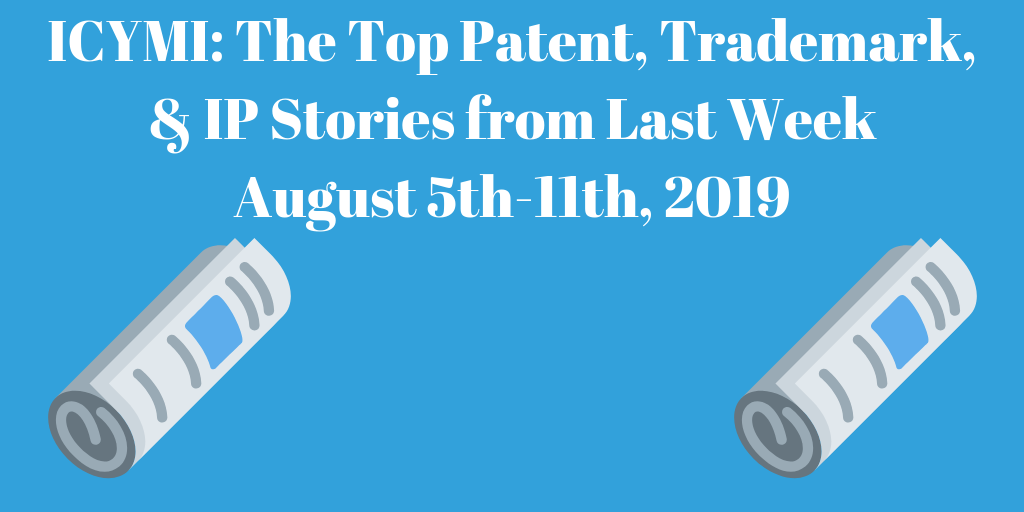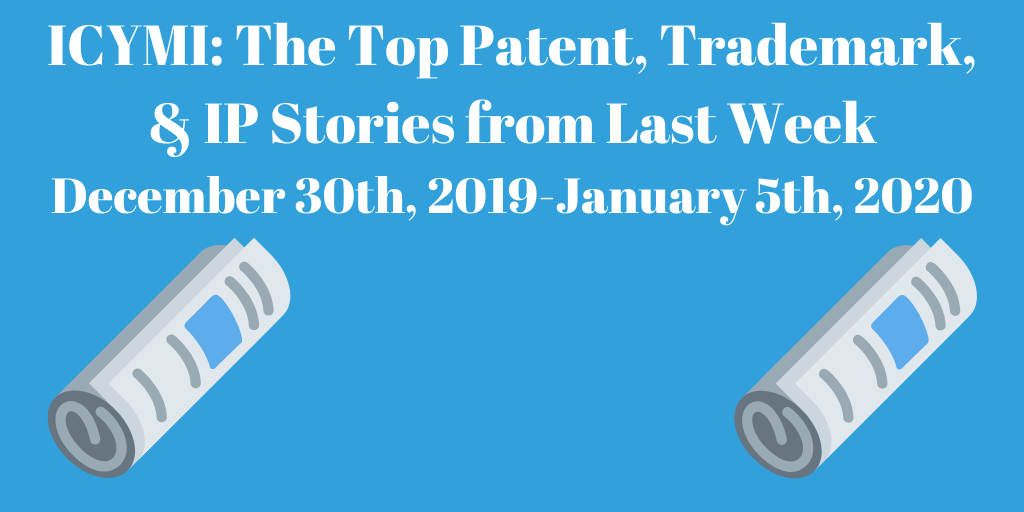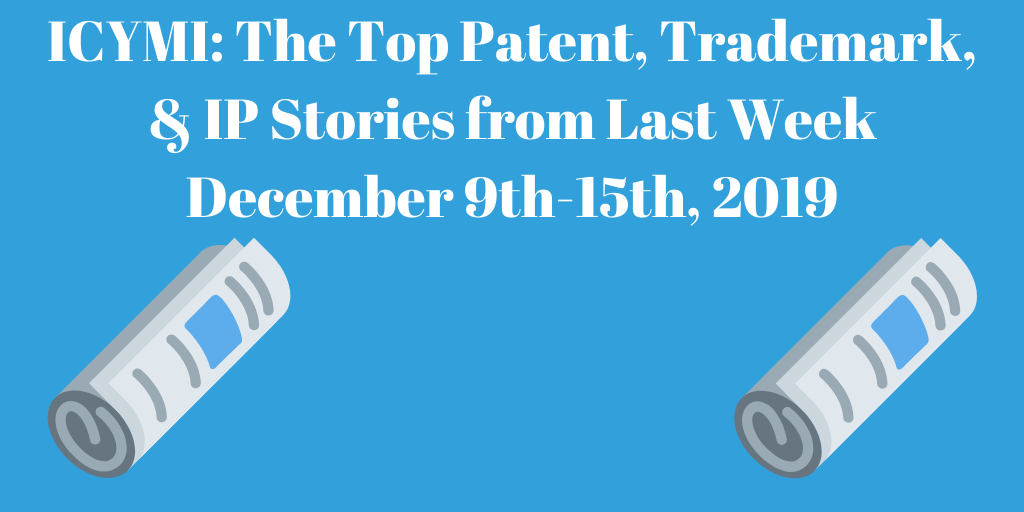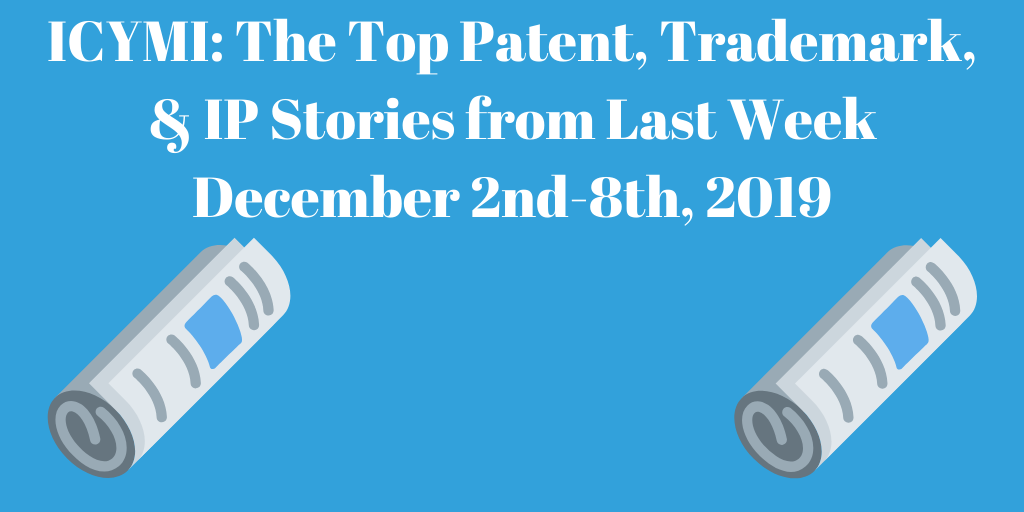Top Patent, Trademark, and IP Stories from Last Week (8/5-8/11/19)
Every week, we will be highlighting the top patent, copyright, trademark, intellectual property, etc. stories of the previous week in our “In Case You Missed It” segment. The list itself is in no particular order and includes a wide range of stories from the patent world that are informative, noteworthy, or just plain bizarre. The stories included encompass everything from Supreme Court cases to insights into growing industries. Please feel free to comment your thoughts on the stories or share an important one we missed!
“Amazon Wins Patent for Spoilage-Sniffing Refrigerator… but Don’t Hold Your Breath”
A new patent from Amazon outlines a fridge that can detect whether food inside it is spoiling with the help of cameras and chemical sensors. Located in each drawer and on each shelf of the fridge, the chemical sensors and cameras would never let a rotten piece of food go out of sight.
Chemical sensors would detect the chemical byproducts of spoiling processes including oxidation, fermentation, rancidification, ripening, etc. Such chemical byproducts would include ethylene via ripening, alcohols via fermentation, acetic acid via fermentation or oxidation, various volatile aldehydes, ketones, and short-chain fatty acids via rancidification, and others. Sensors would include “potentiometric sensors, chemical field-effect transistor (ChemFET) sensors, chemiresistors, chemoreceptors, or other sensors.”

As for the camera technology, the patent indicates the cameras would be infrared and/or visible spectrum cameras. The cameras would take pictures of food routinely and use machine-learning algorithms in order to “create an accurate model for the appearance of a spoiled food item.” The camera would then be able to use the model as a reference for spoiled food.
When spoiled food is detected, whether it be by camera or chemical sensor, the fridge will send a notification to the owner’s smartphone app. Despite such sophistication, maybe the ol’ sniff-and-taste test will work just fine. To read more about this story, click here (via Geek Wire, August 7th, 2019).
“Now McDonald’s Can’t Stop All Its Rivals Using the ‘Mc’ Label”
Back in January we covered how the European Union Intellectual Property Office revoked McDonald’s trademark rights for the “Big Mac” in the E.U. In that case, the EUIPO found the burger’s name infringed on the trademarked name of Irish fast food chain “Supermac’s.” The David vs. Goliath ruling came as a shock to many given McDonald’s name recognition and resources around the world.
Last week, the fast food giant was dealt a second blow as the E.U. once again stripped McDonald’s of trademark rights. In this ruling, the court ruled their “Mc” trademark was no longer protected outside of certain products which were synonymous with the “Mc” prefix including McNuggets, McChickens, and McMuffins. Protection was stripped for use of “Mc” on other products including café products such as coffee and tea, restaurant services, and “any foods prepared from meat, poultry, fish, pork, vegetables, pickles or dairy products.”
McDonald’s had previously trademarked the “Mc” prefix in 2012 for use on products and in their restaurant however Supermac’s argued that McDonald’s failed to show “genuine use” of the trademarks. The court agreed. To read more about this story, click here (via Yahoo! Finance UK, August 7th, 2019).
“USPS Patent Envisions Sorting Robots Aboard Mail Trucks”
A new patent from the USPS outlines a process for delivering and sorting mail with the aid of a giant robotic arm in the delivery truck. The robotic arm inside would sort packages during a route and pass them to the driver for delivery when at the correct address. The robot would also be able to shrink wrap multiple packages going to the same address as one. This would allow for easier delivery for the operator as well as reduce the possibility of items going lost.

A camera on the robot would be able to read information on the packing label and sort accordingly. The invention, if made reality, would eliminate the time and effort necessary to sort packages. To read more about this story, click here (via SupplyChainDrive, August 6th, 2019).
“The Patents Behind Seven Classic Back-to-School Supplies”
A pretty cool article from the Smithsonian reviews the patents behind some of the most iconic school supplies including the pencil with eraser combo, granted in 1858. Ironically enough, the Supreme Court later ruled in 1875 the combo was not patentable. The court ruled “a combination, to be patentable, must produce a different force, effect, or result in the combined forces or processes from that given by their separate parts. There must be a new result produced by their union; otherwise it is only an aggregation of separate elements.” The simple application of an eraser to a pencil was not patentable.
Other inventions include flexible rulers, patented in 1902, and Magic Markers, patented in 1953. To read more about this story, click here (via Smithsonian, August 8th, 2019).
“Xiaomi Patents a New Smartphone Design With an Integrated Solar Panel”
Chinese electronics manufacturer Xiaomi has recently filed a design patent for a smartphone featuring a solar panel on the back. The solar panel will allow the phone to be charged via the sun however counterparts before it, such as the Samsung E1107, have failed to provide adequate charging abilities. Read about it here.




